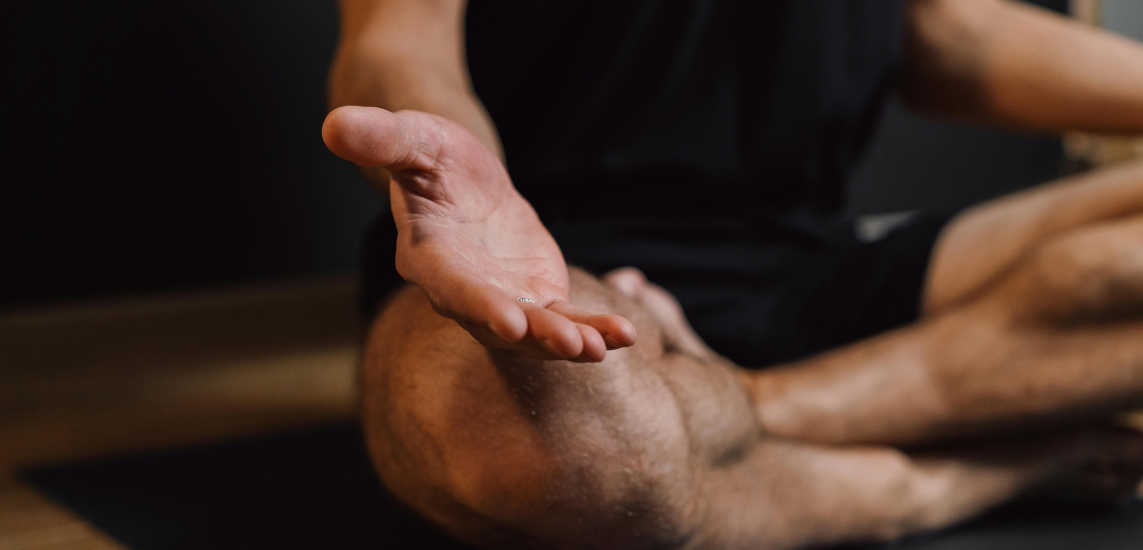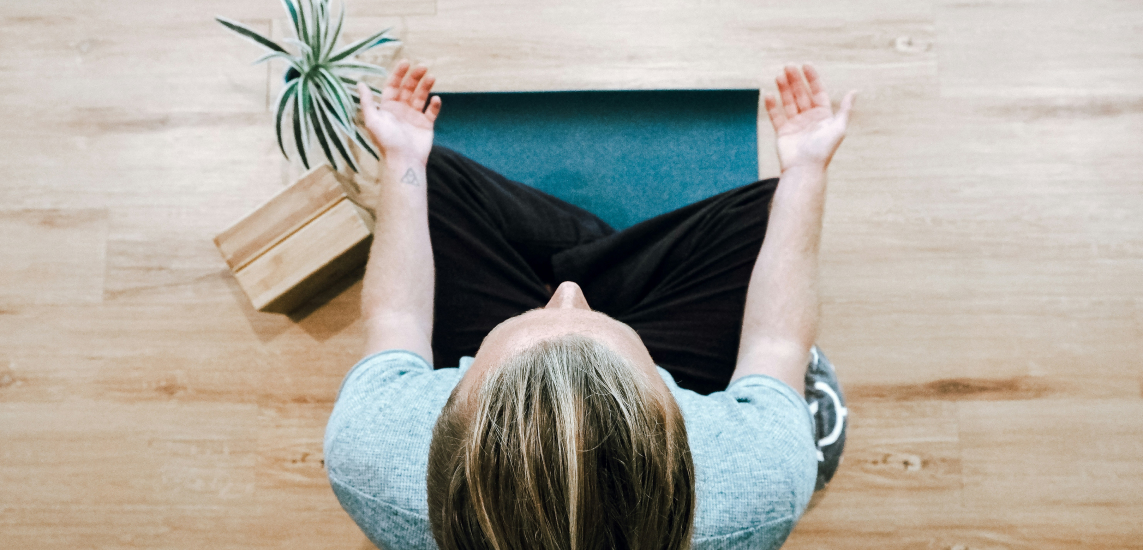Guided meditations give you clarity of mind and a fresh perspective on life. But if you’re just starting this practice, you may notice that your back hurts while meditating in a seated posture for long periods.
An aching or sore lower back during meditation is common. Sitting meditations require significant spinal stability and strength. Discomfort is fairly inevitable until you build up postural strength.
This article explores the causes of lower back pain and explains how to tell which back pain is serious and which is nothing to worry about, how to sit in meditation to avoid lower back pain, and how to use soothing guided meditations to focus on a healthy lower back.
Key takeaways
- It’s common to experience discomfort in your lower back while meditating. You need to build back muscle strength to adjust to the required posture.
- You can minimize discomfort and avoid pain with proper posture, the use of props, stretching, and core strengthening.
- If you experience an injury, unexplained weight loss, or persistent pain, consult a healthcare professional immediately.
- Different meditation positions can help with lower back pain, including sitting poses (thunderbolt and camel pose) or lying positions (bridge and corpse pose).
- Be patient with yourself — building comfort in meditation takes time and practice.
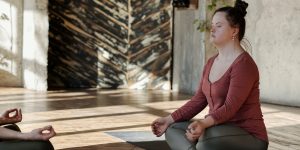
Differentiating discomfort from pain: Is it normal to feel pain during meditation?
The short answer is yes. But it’s not that simple, and there are very good reasons to be sure nothing serious is going on. Let’s dive in.
If you feel soreness from sitting upright for too long, it may be tempting to slouch. But, according to studies, meditating with a round or hunched back is a non-ideal meditation posture.
If you sit hunched over for long periods of time — like over a computer — sitting in more upright positions, especially when meditating, can put extra strain on your back muscles and joints. This can happen from weak muscles but also from more serious conditions like lumbar lordosis, a posture where your lower back is curved too much in an exaggerated C-shape.
Pain during meditation can also occur when you don’t curve your back enough. In this instance, studies suggest, your spine lacks the natural S-curve, making your back appear completely flat.
Some discomfort is okay
According to Mindfulness in Practice, a certain level of discomfort is to be expected from sitting meditation. On the 1-to-10 visual analog scale (VAS), acceptable meditation pain is closer to zero than 10. Severe pain, or pain with a VAS score nearing 10, is usually a sign of something serious.
It’s recommended to keep an eye out for certain events or warning signs, like a recent back injury, surgery, fever, unexpected weight loss, or bladder or bowel trouble, as they suggest a more serious condition underlying the pain.
What are the causes of back pain while meditating?
Most back pain comes from everyday activities, like lifting heavy objects and bad posture, or isn’t specific to one cause. This kind of pain usually resolves on its own.
Less common back pain causes include swelling, infections, and other diseases. Sometimes, inflammation in other parts of your body, like your gallbladder or lungs, can cause back pain. This is called referred pain.
You can tell that your back pain is due to meditation by the timing: It arises only after meditating for long periods of time and improves after changing positions, combined with the lack of warning signs previously mentioned.
So, why does your back hurt when you meditate?
When you’re sitting cross-legged or in a lotus pose during meditation, studies explain, you’re likely to curl your lumbar (lower) back under into a ‘C’ shape unless your hips are very open. This position also causes your pelvis to roll backward and tuck under, opposite of your lumbar spine’s resting shape.
When you sit in a chair or stand, your lumbar spine’s resting shape is usually a lordotic or ‘sway’ position, which then changes to a ‘C’ or kyphotic shape in your middle back or thoracic spine.
Your pelvis and lumbar spine are linked. The rotation of your pelvis is directly related to the shape of your lower back. Studies confirm that when you tuck your tailbone underneath you (with your lower back in a ‘C’ or kyphotic shape) for long periods, such as during seated meditation, the structures in your back can become irritated. This isn’t serious, but it can cause an achy position that eases when you put your hands in the small of your back and stretch backward.
Learn about the reasons you feel sore during meditation and how to alleviate common aches, like knee pain, ankle pain and neck pain.
Can meditation improve back pain?
Yes, there’s evidence that it can. A study found that mindfulness-based stress reduction — one form being seated meditation — can improve both quality of life and how people experience pain, including chronic back pain.
However, it’s important to talk to your primary care provider before starting any new treatment, including meditation, for any medical condition.
Conventional back pain treatments that medical providers may recommend include the following:
- regular exercise to help your body move better, gain muscle, and prevent weight gain (which can worsen back pain)
- avoiding triggers that make your pain worse, like poor posture and lifting heavy objects
- hands-on therapy, which may involve massage or other techniques to help your muscles and joints
- understanding what makes your pain better or worse to help you manage it more effectively

Keep in mind that these are just general guidelines, and the best approach depends on the specific cause and severity of your back pain.
Ready to dive in? Explore this meditation playlist specifically addressing back pain. Bookmark the back pain meditation practice playlist here.
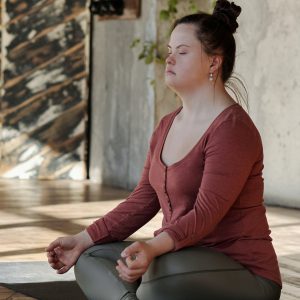

- Releasing Tension: Low Back Paige Gilchrist 19:26
- Supple Low Back Margaret Rinaldi 22:29
- Relieve Low Back Pain With Movement Dayana 29:44
- Soothe & Heal Your Spine Jac Godsman 08:47
- Compassion Meditation For Back Pain The BioMedical Institute of Yoga and Meditation 09:02
- The Tension Release Meditation Vidyamala Burch 05:45
- Breath and Spine Kerri White 27:25
How to stop back pain when meditating
A great seated meditation posture, according to studies, is all about avoiding the ‘C’ shape posture with your tailbone tucked underneath you. Sitting with your pelvis gently rotated forward (anterior tilt), and your lumbar spine slightly swayed is key. However, for most people, this position can feel challenging after a few minutes.
So, here are some tips to minimize the back pain:
- Sit on a yoga block or pillow. This elevates the pelvis, allowing it to roll slightly forward and let the spine achieve its natural ‘S’ shape. You may need a stack of blocks or pillows to find the best position for your body.
- Sit on the corner of a stack of blankets. By sitting on the corner, your thighs are off the edge and lower than your pelvis to allow for forward pelvic rotation.
- Stretch your hips out first. Pigeon pose can be a great pre-meditation stretch to ease the structures around the hips and help you sit cross-legged or in a lotus position more easily.

The best meditation postures for people with back pain
Sitting well during meditation is all about finding the right posture.
Physiotherapist Caitlin Reid shares her experience, “A lot of my patients see me for low back pain caused by long periods of sitting, including working at their desks, sitting on the couch, or doing meditation. [They are] understandably frustrated because they can’t sit comfortably, so as part of their treatment, we work on avoiding that painful posture. It’s about sitting with their spine in a better position to help prevent pain.”
Seated meditation positions
How you sit makes all the difference, and it comes down to anatomy. Two seated positions that yoga practitioners recommend are the thunderbolt and camel poses, so long as precautions are followed. Remember, you can meditate in these poses with props like a pillow for added comfort.
Thunderbolt pose
The thunderbolt pose, or vajrasana, is a sitting-kneeling position in which you sit back on your heels. Knees should be hip-width apart with the toes touching, and your back should be straight. This pose benefits digestion and leg strength. However, be mindful of alignment. Sitting for too long or applying pressure to the sciatic nerve can cause pain and hinder mobility.
Camel pose
The camel pose, or ustrasana, is a backbending-sitting position that improves flexibility and digestion and relieves tension. To perform it safely, start slowly, warm up your spine with other poses, and avoid overextending the back. Focus on keeping your hips stacked over your knees, lifting your chest, and lengthening your neck to prevent injuries.
Lying meditation positions
Lying meditation positions are good alternatives to seated poses for people who struggle to sit for any duration of time. Recommended lying positions include the bridge and corpse poses.
Bridge pose
The bridge pose, or setu bandha sarvangasana, stretches the chest, neck, spine, and thighs. Raise your stomach up from a lying position, and hold the “locked bridge” with feet hip-width apart and arms reaching back toward the ankles. This calming pose eases headaches, fatigue, and insomnia, but avoid it if you have neck or shoulder injuries.
Corpse pose
Corpse pose, or mirtasana in hatha yoga, involves simply lying flat on the ground with your palms up. This posture is believed to relieve fatigue and mental agitation.

Build muscle and alleviate back pain
If you’re finding your lower back gets sore after meditating for 10 minutes, that’s okay. Your strength will build slowly over time. In the meantime, posture is key. If you start to feel discomfort in your body while meditating, it’s okay to get up and change position after 10 minutes, then continue meditating.
Strengthening your core muscles, especially those in your trunk, is also a recommended treatment for both acute and chronic back pain by the Academy of Orthopedic Physical Therapy and the American Physical Therapy Association. Stronger core muscles help support your lower back, helping reduce pain.
Pushing through discomfort can be a goal of meditation as long as it’s not serious pain. Trying to push through each time will help you build more strength. Just like going for a run, you won’t get fitter if you don’t try to run a bit further or faster every few weeks.


- Sitting Through Discomfort Mel A. James 11:25
- Working with Difficult Bodily Sensations Hugh Byrne 15:08
- Breathing Through Pain And Discomfort Jamie Krasman 9:34
- Sit With Your Discomfort Jelena Fu 10:10
- Pain and Discomfort Meditation Joelle Anderson 20:00
- Gratitude Practice For Discomfort And Difficulty Dr. Candice Creasman 10:02
- Finding A Way Through Physical And Emotional Discomfort Anne Marie Wallen 23:02
- Accepting Emotional Discomfort Dr. Julien Lacaille (MindSpace) 16:13
- Beyond Pain Mary Maddux 15:46
- Making Peace With Physical Discomfort Andrea Zimmering 08:05
- From Pain to Peace Bethany Auriel-Hagan 15:36
- Journey Through Pain Short Version Andy Hobson 13:51
- Resting With Discomfort Lisa Meuser 10:09
- Sitting With Discomfort A. M. Wegner 9:59
- Learning To Sit With Discomfort Kate Heironymus 9:55
- Meditation for Comfort & Ease in the Body Jennifer Meek 10:00
Strengthening your meditation practice means embracing discomfort
Once you’re sure your aching isn’t serious, sitting in a specific posture or using a pillow to help your position eases discomfort during meditation.
Be patient with yourself. Building comfort and proper posture in meditation takes time and practice.
With the right approach and guidance, you can enjoy the benefits of meditation without back pain hindering your practice.
New to meditation? This 5-day course, led by meditation expert Rev. Skip, is perfect for beginners. You’ll learn the basics of mindfulness and explore different meditation types. You’ll love how meditation can benefit you, whether you’re just beginning your meditation journey or seeking to advance your meditation practice.
FAQs
How do you deal with leg pain, soreness, aches, itchiness, and numbness while meditating?
Leg pain, soreness, aches, itching, or numbness while meditating aren’t necessarily signs of something serious. Just like sitting in any position for a long time, holding a meditation posture can make your legs feel uncomfortable. Adjust your posture to ease these discomforts, or use props like cushions or a meditation bench to find what feels best for you.
But if these symptoms keep happening after you adjust your posture, especially if you have ongoing back pain and any of the risk indicators mentioned earlier, this could be a sign of a more significant health concern. In this case, you may require a doctor’s evaluation to determine the cause of your pain.
Is it better to meditate sitting or lying?
You can meditate in any position that makes you comfortable and doesn’t disrupt your practice. Some people find it easier to focus on their body when they are lying down. It’s important to be in a comfortable position and have good spinal alignment while doing so.
Learn more about how and when you should meditate lying down.
How can beginners use meditation techniques to manage chronic pain?
Mindfulness-based stress reduction (MBSR) or mindfulness meditation can significantly improve how pain is perceived, providing relief for people with chronic low back pain. MBSR offers a unique combination of mental and physical techniques to manage chronic pain. Beginners can use mindfulness meditation to take control of the pain experience by increasing their awareness and reducing anxiety and tension in reaction to the pain.
Other mindfulness meditation techniques include body scans, sitting and walking meditation, yoga, and stretching.
What are some comfortable meditation positions for someone with lower back pain?
People with lower back pain should find a meditation position that keeps their spine in a natural alignment. The key is to maintain good posture and incorporate mindful movement before meditating. Sitting on a meditation cushion or folded blanket can help if you can’t do it on your own. Leaning against a wall with your legs stretched out in front of you is another option.
References
Alfalogy, E., Mahfouz, S., Elmedany, S., Hariri, N., & Fallatah, S. (2023). Chronic Low Back Pain: Prevalence, Impact on Quality of Life, and Predictors of Future Disability. Cureus, 15(9). https://www.ncbi.nlm.nih.gov/pmc/articles/PMC10590648/
Bond, M. (2022). Your Spine Is Not a Column. Structure, Function, Integration, 50(1), 18-23. https://novo.pedroprado.com.br/wp-content/uploads/2022/06/05_Your-Spine-Is_-DIRI_Journal_March_2022_Interactive_28.pdf
Casiano, V. E., Sarwan, G., Dydyk, A. M., & Varacallo, M. (2023). Back Pain. StatPearls Publishing. https://www.ncbi.nlm.nih.gov/books/NBK538173/
Corp, N., Mansell, G., Stynes, S., Wynne-Jones, G., Morsø, L., Hill, J. C., & van der Windt, D. A. (2021). Evidence-based treatment recommendations for neck and low back pain across Europe: A systematic review of guidelines. European Journal of Pain, 25(2), 275–295. https://doi.org/10.1002/ejp.1679
DePalma, M. G. (2020). Red flags of low back pain. Journal of the American Academy of Physician Assistants, 33(8), 8-11. https://doi.org/10.1097/01.JAA.0000684112.91641.4c
Deyo, R. A., Dworkin, S. F., Amtmann, D., Andersson, G., Borenstein, D., Carragee, E., Carrino, J., Chou, R., Cook, K., DeLitto, A., Goertz, C., Khalsa, P., Loeser, J., Mackey, S., Panagis, J., Rainville, J., Tosteson, T., Turk, D., Von Korff, M., & Weiner, D. K. (2015). Report of the NIH Task Force on Research Standards for Chronic Low Back Pain. International Journal of Therapeutic Massage & Bodywork, 8(3), 16–33. https://www.jpain.org/article/S1526-5900(14)00680-4/fulltext
Du, S., Zhang, Y., Yang, Q., Wang, Y., Fang, Y., & Wang, X. (2023). Spinal posture assessment and low back pain. EFORT Open Reviews, 8(9), 708-718. https://doi.org/10.1530/EOR-23-0025
George, S. Z., Fritz, J. M., Silfies, S. P., Schneider, M. J., Beneciuk, J. M., Lentz, T. A., Gilliam, J. R., Hendren, S., Norman, K. S., Beattie, P. F., Bishop, M. D., Goertz, C., Hunter, S., Olson, K. A., Rundell, S. D., Schmidt, M., Shepard, M., & Vining, R. (2021). Interventions for the Management of Acute and Chronic Low Back Pain: Revision 2021. Journal of Orthopaedic & Sports Physical Therapy, 51(11), 531-550. https://www.jospt.org/doi/epdf/10.2519/jospt.2021.0304
In, T., Jung, J., Jung, K., & Cho, H. (2021). Spinal and Pelvic Alignment of Sitting Posture Associated with Smartphone Use in Adolescents with Low Back Pain. International Journal of Environmental Research and Public Health, 18(16). https://doi.org/10.3390/ijerph18168369
Irani, G. S. (2020). Injuries/Harms Resulting from Incorrect Adjustments/Alignments Performed by Yoga Asana Practitioners. Archives of Pharmacy Practice, 11(3), 38-47. https://archivepp.com/storage/models/article/X7CQtiRRH3VDs0GMJ6IiZ95wgF5cR1PD99hVoIBVgeFQqvacDAmuL4LLrQuE/injuriesharms-resulting-from-incorrect-adjustmentsalignments-performed-by-yoga-asana-practitioners.pdf
Jiang, Y., Wang, Y., Wang, R., Zhang, X., & Wang, X. (2022). Differences in pain, disability, and psychological function in low back pain patients with and without anxiety. Frontiers in Physiology, 13. https://www.ncbi.nlm.nih.gov/pmc/articles/PMC9669742/
Jo, S. (2019). How to Sit in Sitting Meditation. Mindfulness, 10, 2468–2471. https://doi.org/10.1007/s12671-019-01189-5
Jung, K. S., Jung, J. H., In, T. S., & Cho, H. Y. (2020). Effects of Prolonged Sitting with Slumped Posture on Trunk Muscular Fatigue in Adolescents with and without Chronic Lower Back Pain. Medicina (Kaunas, Lithuania), 57(1), 3. https://doi.org/10.3390/medicina57010003
Kendroud, S., Fitzgerald, L. A., Murray, I. V., & Hanna, A. (2022). Physiology, Nociceptive Pathways. StatPearls Publishing. https://www.ncbi.nlm.nih.gov/books/NBK470255/
Matko, K., & Sedlmeier, P. (2019). What Is Meditation? Proposing an Empirically Derived Classification System. Frontiers in Psychology, 10, 2276. https://www.ncbi.nlm.nih.gov/pmc/articles/PMC6803504/
Pandi-Perumal, S. R., Spence, D. W., Srivastava, N., Kanchibhotla, D., Kumar, K., Sharma, G. S., Gupta, R., & Batmanabane, G. (2022). The Origin and Clinical Relevance of Yoga Nidra. Sleep and Vigilance, 6(1), 61–84. https://doi.org/10.1007/s41782-022-00202-7
Sassack, B., & Carrier, J. D. (2023). Anatomy, Back, Lumbar Spine. StatPearls Publishing. https://www.ncbi.nlm.nih.gov/books/NBK557616/
Singh, P. K., Mishra, J. P., & Singh, R. K. (2022). Effect of Meditation on Mental Health and Physical Health. International Journal of Novel Research and Development, 7(3), 640-648. https://www.ijnrd.org/viewpaperforall?paper=IJNRD2203078
Smith, S. L., & Langen, W. H. (2020). A Systematic Review of Mindfulness Practices for Improving Outcomes in Chronic Low Back Pain. International Journal of Yoga, 13(3), 177–182. https://www.ncbi.nlm.nih.gov/pmc/articles/PMC7735497/
Zemková, E., & Zapletalová, L. (2021). Back Problems: Pros and Cons of Core Strengthening Exercises as a Part of Athlete Training. International Journal of Environmental Research and Public Health, 18(10), 5400. https://doi.org/10.3390/ijerph18105400
Disclaimer: This article is for information only and should not be considered as medical advice. If you have concerns about low back pain or any other conditions mentioned in this article, please seek a medical professional for help.

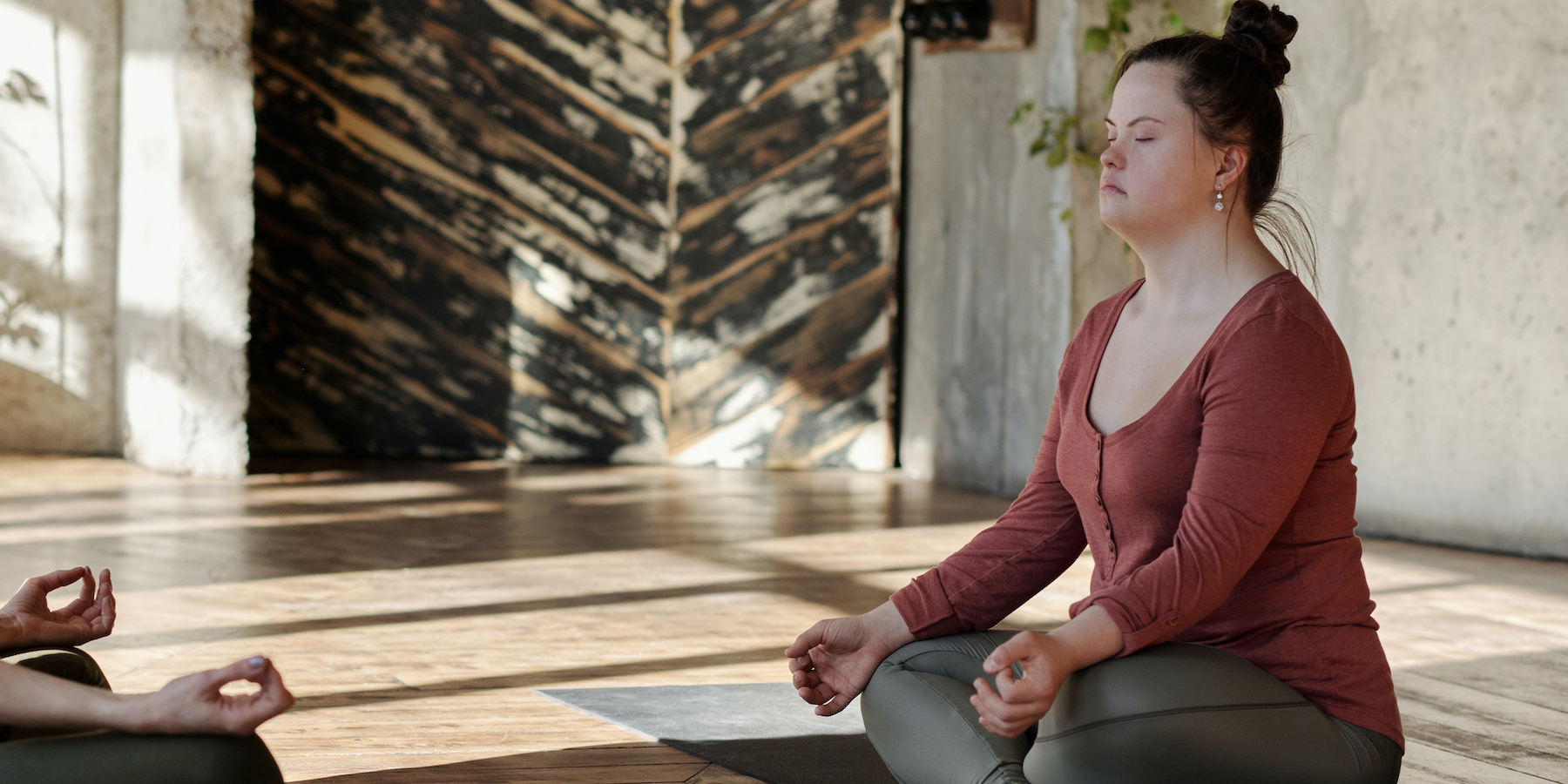


-1.jpg)
